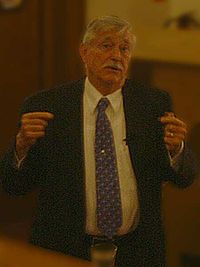This is an old revision of this page, as edited by Cydebot (talk | contribs) at 04:46, 21 June 2006 (Robot - Moving category Fringe physics to Pseudophysics per CFD at Misplaced Pages:Categories for deletion/Log/2006 June 12.). The present address (URL) is a permanent link to this revision, which may differ significantly from the current revision.
Revision as of 04:46, 21 June 2006 by Cydebot (talk | contribs) (Robot - Moving category Fringe physics to Pseudophysics per CFD at Misplaced Pages:Categories for deletion/Log/2006 June 12.)(diff) ← Previous revision | Latest revision (diff) | Newer revision → (diff)
Halton Christian Arp is an American astronomer. He was born March 21 1927 in New York city. His bachelor's degree was awarded by Harvard (1949), and his Ph.D. from Caltech (1953). Afterwards he became a Fellow of the Carnegie Institution of Washington in 1953, performing research at the Mount Wilson Observatory and Palomar Observatory.
He became a Research Assistant at Indiana University in 1955 and subsequently in 1957 became a staff member at Palomar Observatory, where he worked for 29 years. In 1983 he joined the staff of the Max Planck Institute in Germany.
Arp is known for his controversial hypothesis that quasars (QSO's) are local objects ejected from the core of active galactic nuclei (AGN). While very few researchers accept Arp's hypothesis at this time, if Dr. Arp is correct that many QSO's are local, then most of the observed redshift of these QSO's must have a non-cosmological or "intrinsic" origin. This hypothesis is in contrast to the standard view that the observed redshifts of most extragalactic objects is dominated by a cosmological redshift component from expansion of the universe. In his books Dr. Arp has provided his reasons for believing that the Big Bang theory itself is wrong.
Working with Dr. Jayant Narlikar, Dr. Arp has proposed a "Variable Mass Hypothesis" (VMH). In this alternative hypothesis, the QSO's ejected from AGN contain subatomic particles with smaller masses than the protons, neutrons, and electrons observed on Earth. In the VMH, it is hypothesized that as a QSO ages, the particle masses increase. This VMH is proposed as an explanation for the hypothesized intrinsic redshifts, but has not yet gained support in the astronomical community. He has also compiled a catalog of unusual galaxies: Atlas of Peculiar Galaxies.
In 1960, Arp was awarded the Helen B. Warner Prize for Astronomy by the American Astronomical Society.
See also
- Main : Controversial book (Quasars, Redshifts and Controversies)
- List of astronomical topics : Quasar
- Cosmology : Non-standard cosmology, Steady state theory, Plasma cosmology, Le Sage's theory of gravitation, Big Bang
- Other : Helen B. Warner Prize for Astronomy
Further reading
- Halton Arp, Quasars, Redshifts and Controversies, Interstellar Media (May 1, 1987) ISBN 0941325008
- Halton Arp, Seeing Red, Aperion (August, 1998) ISBN 0968368905
- Halton Arp, Catalogue of Discordant Redshift Associations, Aperion (September 1, 2003) ISBN 0968368999
- G. Burbidge, E.M. Burbidge, H.C. Arp, W.M. Napier: Ultraluminous X-ray Sources, High Redshift QSOs and Active Galaxies. Preprint
External links
- Halton Arp's Website
- Apeiron Arp's journal
- Atlas of Peculiar Galaxies
- Arp's Catalog of Peculiar Galaxies website
This article about an astronomer is a stub. You can help Misplaced Pages by expanding it. |